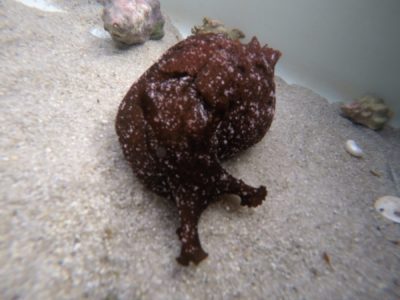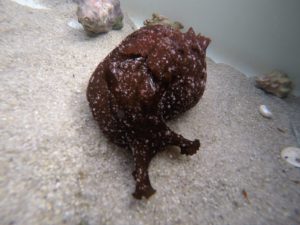
Don’t get confused by the name, California sea hares are actually a type of sea slug commonly found in intertidal zones along the coast of California and Mexico. Their color depends on the food they eat. One of their favorite foods is the red algae plocamium, which is what gives many of them a pinkish-red color, but others can appear more brown. This helps the sea hare blend into their environment, and they will usually spend most of their time hiding in intertidal seaweed. Sea hares accumulate toxins from the algae they eat and store them in their body, making them distasteful to most predators. When attacked, California sea hares will expel a bright purple ink, which is mildly toxic to some animals.
Though sea hares like to live in shallower waters, they cannot move around outside of the water like other intertidal creatures. Their soft bodies are supported by a hydrostatic skeleton, which is a system of fluid-filled cavities surrounded by muscle. When the sea hare moves, it changes shape by flexing these muscles and pushing the fluid in different directions. This only works because the pressure of the fluid inside the sea hare’s body is equal to the pressure of the water outside it. Outside of water, this system breaks down, and the sea hare turns into a shapeless, immobile lump.

Sea hares have been compared to rabbits since ancient times because of the ear-like structures on top of their heads. These are actually chemical receptors called rhinophores, which the sea hare uses to detect dissolved chemicals in the water. This helps it locate food and track down the pheromone secretions of other sea hares. Sea hares are hermaphrodites, which means they possess both male and female parts. Once one or more potential mates are found, they will sometimes form daisy chains, which is a line of slugs all mating at once.
It is hard not to fall in love with the sea hare. Their squishy bodies and bunny-like appearance make them very charismatic representatives of the amazing creatures we can find in the intertidal zone. Next time you go tidepooling, take a peak in the seaweed and see if you can find one of these camouflaged algae-lovers. Just make sure you keep that hydrostatic skeleton intact and leave it in its watery home.
Written by: Megan Petkovic


